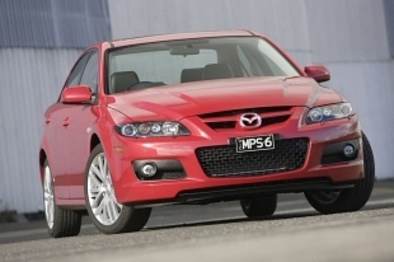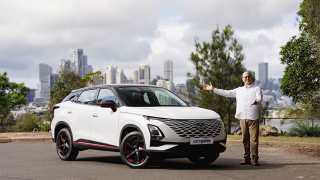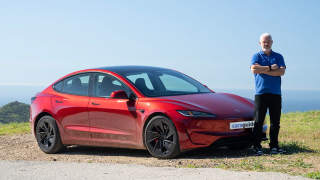
Mazda 6 2007 Review
- Mazda 6
- Mazda 6 2007
- Mazda 6 Reviews
- Mazda Reviews
- Mazda Sedan Range
- Mazda Wagon Range
- Mazda Hatchback Range
- Sedan
- Wagon
- Hatchback
- Mazda

Mazda's much anticipated king hitter of the medium segment arrives ahead of schedule in Australia early next year sporting an arsenal of firepower but with one potentially crucial missing link.
Short of claiming the Mazda6 is set to deliver a killer punch in its second generation ahead of its March arrival, there is one glaring omission; satellite navigation.
It has frustrated Mazda Australia who are unsure when a guidance system will become available.
A series of frustrating supplier issues means it will not be seen anytime soon after launch.
That is one of the few sour points for the all-new 6 that should arrive for a similar price to the outgoing model which, in itself is quite an achievement, considering the more than credible generational changes.
As before, the 6 comes in three body styles (sedan, hatch and wagon) with the same four trim levels.
The range is expected to start somewhere around the current run-out price of $29,490 for the base Limited (sedan only), which comes with all the safety gismos including Dynamic Stability Control, six airbags, active head restraints and traction control and 16-inch steel wheels.
Rising to the Classic (all body styles), which accounts for 40 per cent of volume as opposed to the 10 per cent for the base model, there are 17-inch alloy wheels and the new dual-zone climate control automatic aircon.
The Luxury (30 per cent of sales) will come in the sedan and hatch with a wagon version still to be confirmed that gains the leather interior, electric seat adjustments, steering wheel-mounted paddles for the Activematic transmission and xenon headlamps as opposed to the bi-xenon's of the European-spec car.
The Australian car otherwise mirrors that of the European version with the range-topping Luxury/Sport model shod with 18-inch rubber.
Mazda considers the big demand will be for the luxury in the early months of sales, which indicates to them that they have the production specification mix on track.
A decision on whether Australia will take the Luxury wagon variant is yet to be made, the official line being that feedback will dictate its fate with the ultimate call probably made at the domestic launch.
The six-speed manual is available on all models while the five-speed Activematic is expected to fetch a $2200 option fee.
Mazda has continued its impressively scientific way of extracting weight from the car, which started with its 'gram' philosophy that began with the MX-5 roadster retractable hardtop of a couple of seasons ago and passed on to the recently launched Mazda2.
There is no official kerb weight on the Australian-spec cars, as the production run has not yet started, although the model's program manager, Ryuichi Umeshita, assures that it will match the outgoing model's mass.
Without the weight saving measures on the new car, Umeshita says the Australian 6 would be carrying 110kg more bulk.
The Euro model reaches showrooms with 35kg shaved off the kerb weight.
This is despite the fact that the new Mazda6 has grown in specification and, more importantly, in dimensions with the sedan and hatch up 65mm to 4735mm in length, a 15mm lift in width to 1795mm, 5mm rise in height to 1440mm and a significant 50mm more in wheelbase which extends to 2725mm.
The wagon is 75mm longer, 15mm wider, 10mm taller and measures the same in wheelbase length.
In proportion Mazda has increased the diameter of the brake discs by 16mm.
A particularly impressive breakthrough is the NVH (noise, vibration, harshness), which is down by 2.5dB to 67.5dB on a coarse chip bitumen road at 60km/h. High levels of attention to acoustics in the body and underbody sound deadening as well as quieter suspension bushes have helped make the new 6 the most serene Mazda yet.
This is also the slipperiest Mazda ever with a drag coefficient of .27 down from .30 on the previous model in the sedan and .28 for the wagon, a reduction of .04 from the outgoing version.
There is a veritable motor racing factory methodology behind Mazda's approach with fancy under body wings like a horseshoe-shaped tyre deflector, which helps the aero stability yet does not impinge on brake cooling.
A soft-close function, in the ilk of luxury German cars, will be standard for the hatchback models; while the wagon features a practical new tonneau cover that blocks out intrusive eyes to the cargo area automatically when the rear door is closed.
One big tick for this model is the decision to offer metallic paint standard, a move which is a huge hit with buyers.
Another bonus is the electric power assisted steering system.
These systems have not been warmly received on some rival cars in the past, largely for their artificial feel.
But this electric assist deal has been meticulously engineered with more than 150 calibrations measured and tested in real world situations, which took two years to develop what the optimum setting in steering linearity and preciseness would be.
Of course all this development would not be complete if there was no advance in fuel economy figures.
The new steering system alone helps reduce fuel consumption with Mazda claiming in-house that the figures on the Limited manual model are 8.1litres/100km.
The new 2.5-litre MZR four cylinder features a new block over the previous 2.3-litre unit and rises by 3Kw in power to 125Kw; while crucially torque goes north to the tune of 19Nm to 226Nm.
A new easy-to-use steering wheel-mounted button system called Cross-Functional Network (CF-Net) helps you cycle through audio, navigation (when it arrives), air-con, trip computer and Bluetooth.
Among those benchmarked for the new 6 were the Volkswagen Passat and the 3-series BMW for driving dynamics along with the Subaru Liberty.
Australia will not receive the current 2-litre diesel when the cars are launched in March.
The wait is for a more powerful and more torque 2.2-litre version on stream in 2009 with an automatic transmission.
First Drive
Mazda has unlocked the secret to building sausage factory cars that haven't had the life and soul sucked out of them.
The first generation Mazda6 was a megahit, responsible for lifting the company out of an abyss that threatened its existence through the 1990s.
This medium sized passenger car, launched in 2002, was responsible for getting Mazda out of trouble in one of the automotive world's most stunning revivals.
It was a good, honest vehicle with conservative styling and conservative road manners.
There was nothing special, nothing startling about the 6. It simply was; and still is; a good solid package.
Five years on, it is time for the second iteration of the Mazda6, which now takes the game to a whole new level.
The second attempt gains ground in a number of specific areas; engine, noise and vibration harshness, steering and, as has become expected in most evolutions these days, an increase in the vehicle's dimensions.
Mazda has long been renowned for making desirable driving machines.
In fact few Japanese car makers can rival Mazda's adeptness at engineering a chassis that appeals to the masses and does not alienate any other demographics.
After sampling the new car around the hills and mountains behind the Cote D'Azur between Saint Tropez and Nice in the French Riviera, it is safe to say the new 6 will make a driver smile whether they are 20-something or 80-something.
More so for its levels of refinement, balance, equipment and safety, there is every reason to admire the way it has evolved from a more than capable predecessor.
The sweet MZR 2.5-litre four-cylinder engine is a bored and stroked variation of the previous 2.3-litre power plant.
There is real charm from its stirring note and a degree of flexibility not many four-cylinder engines can boast.
Ride comfort excels over the choppiest surfaces and the electric-servo assisted steering , which is mightily impressive and does not display the artificial numbness of similar systems in rival cars.
It is easy to see how Mazda spent more than two years and 150 different calibrations; trying to fine-tune the feel of the steering and finish with high levels of linearity and precision in the final production version.
Of no less significance is Mazda's ability to eliminate noise from the cabin.
They may have been particularly sensitive on this front as a result of global criticism of the poor NVH quality of its nonetheless well serving first generation smaller Mazda3.
Up to 2.5dB has been erased from unwanted noises entering the cabin, a fair lick by any stretch through various methods including an acoustic body and extensive underbody shielding.
This front-drive sedan (launch version was a 6-speed manual and a cross between luxury and luxury/sport trim) was well behaved in poor weather conditions.
Blustery cross winds challenged the trajectory and the 5C temperatures plus rain squalls left surfaces with less than optimum grip.
The DSC traction system, which comes as a standard feature on all Mazda6s sold, is a saviour for any driver, no matter what their level of competence may be.
It is engineered in a way that it doesn't cut in at the first hint traction has been challenged. There is a high threshold and when it does intervene it eliminates push (understeer) and keeps the whole affair neat and tidy.
There is a blissful combination of chassis dynamics that cross between sporty enthusiasm and a well adjusted ride for those with more conservative bones.
The seats and driving position are perhaps two of the only areas that did not seem to be as sorted as the rest of the package.
There was far too much lateral movement around sweepers and bends and it took a bit of manoeuvring of the electric adjusts to position the seat in the sweet spot for a comfortable height and position to operate the pedals.
That said, there are palpable increases in driver enjoyment over the previous model.
Subjectively, the clarity of design (some claim rather unfairly a bit of Lexus influence) is a big hit and the quality can be measured by the complexity in the front and rear light assemblies; as well as the narrowness of the panel joins.
On first impressions would the inclination be to use those two magic words, 'class winner?'
This 'sixer' is a smash hit as a comfortable transport conveyance as much as it is an enjoyable driving experience.
Snapshot
Mazda6
Price: close to the current model
Body styles: sedan, hatch and wagon
Engine: 2.5-litre DOHC four cylinder
Power: 125kW@6000rpm
Torque: 226@4000rpm
Transmissions: 6-speed manual, five-speed Activematic automatic sequential
Fuel consumption: 8.1l/100km (manual), 8.4l/100km (auto) claimed
Dimensions (MM): 4755 (l) 1795* (w), 1440* (h)
Wheelbase: 2725*
Cargo space: 519litres (sedan), 510litres (hatch)
Pricing guides
Range and Specs
| Vehicle | Specs | Price* | |
|---|---|---|---|
| Limited | 2.3L, PULP, 5 SP AUTO | $5,060 – 7,480 | 2007 Mazda 6 2007 Limited Pricing and Specs |
| Sports | 2.3L, PULP, 6 SP MAN | $5,060 – 7,370 | 2007 Mazda 6 2007 Sports Pricing and Specs |
| Sports | 2.3L, PULP, 5 SP AUTO | $5,940 – 8,360 | 2007 Mazda 6 2007 Sports Pricing and Specs |
| Classic | 2.3L, PULP, 6 SP MAN | $5,830 – 8,140 | 2007 Mazda 6 2007 Classic Pricing and Specs |
$3,750
Lowest price, based on 34 car listings in the last 6 months








